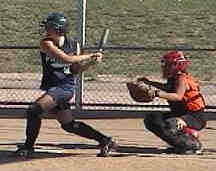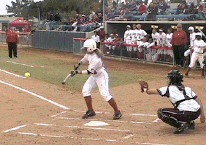
Since one of the primary
measurements of a softball pitcher's effectiveness is her ERA (earned run average), a coach should make certain that
both earned and unearned runs in a game are counted
fairly.
We have seen all too often, that the
official scorekeeper for a game might have a tendency to make
mistakes in scoring…giving a hit when it should have been scored as
an error (or vice-versa), giving the benefit to
the home team's batter or pitcher, etc.

To make it even more unfair for
pitchers, often the scorekeeper does not fully understand the rules
for scoring an earned run. We feel that in a majority of the
situations the person keeping the official scorebook for the game
looks only at how the run-scorer had initially gotten on base to
determine whether or not the scored run was earned or
unearned. As you will see below, scoring rules generally
require that the scorer or coach reconstruct the inning to determine
whether each run would have been scored had it not been for errors
and passed balls.
It is important to note here that you should obtain and
follow the scoring rules as adopted by your team's national, state,
or local association, league, high school athletic association,
etc. Some scoring rules might also refer back to those
organized and detailed by the National Fastpitch Coaches Association
(www.nfca.org). Our role in
discussing this subject is not to make or change the rules that your
team should follow, but instead to point out that many scorers do a
disservice to pitchers by scoring earned runs
erroneously.
Typically, scoring a run as unearned vs.
earned should be determined
by:
1.
The inning should be reconstructed as if it were played without errors and passed
balls to determine which runs scored are earned. When there
is doubt on deciding which bases would have been reached had it
not been for errors, give the benefit to the pitcher (don't automatically assume that a runner would have gotten
extra bases on a hit).
2.
The run is earned if:
the runner who scored
had advanced to each base as a result of any of the
following: hit, walk, hit by pitch, wild pitch, illegal pitch,
stolen base, sacrifice bunt, sacrifice
fly.
The
run is unearned if:
3.
the runner who scored had initially reached 1st base on an error,
or defensive
interference/obstruction.
4. the runner
who scored, when at bat would have been out had it not been for a
dropped foul ball.
5. the runner who
scored had her baserunning life prolonged by an error and
otherwise would have been put out had it not been for the
error.
6. the runner who scored had
advanced by a passed ball or defensive interference, and otherwise
would not have scored.
7. When reconstructing the inning
to determine which runs are earned, a relief pitcher does NOT
receive the benefit of previous chances for outs for the runners
she put on base.
The article above can be downloaded
and printed from Microsoft Word

Do you want to reprint this article or use it
on your website or in your newsletter?
As
long as it is not for profit, our only requirement is that you
first notify us, then include the following
sentence:
Article by Gerald Warner of
PitchSoftball.com
and include a reference to this
website: www.pitchsoftball.com
Home Page | | About Us | E-Mail
Us
More for Coaches & Parents | Beginning
Pitchers | 1st & 2nd Year
Pitchers | Experienced
Pitchers | 





